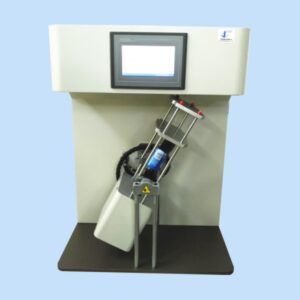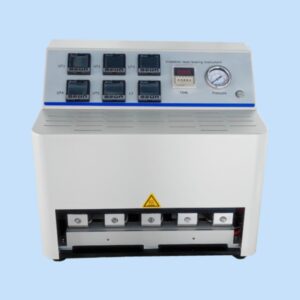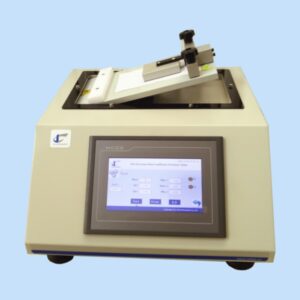TLT-01 Top Load Tester
- Standard: ASTM D2659, ASTM D4577, ASTM D642, ISO 8113, ASTM D4169
- Manufacturer: Cell Instruments
- Applications: Container, Packaging materials, medical device materials, pharmaceutical testing, and more.
- Customization: Available for special testing requirements and automation transformations
I. Introduction to Top Load Tester
Top load tester is a specialized instrument designed to measure the top-load strength and compression resistance of various packaging materials, such as bottles, cans, and containers. This equipment plays a crucial role in assessing the structural integrity of packaging, helping manufacturers ensure that their products can withstand external forces during transportation and handling.
In industries such as packaging, food, pharmaceuticals, beverages, and consumer goods, top load testers are essential tools for maintaining quality control. Key applications of top load testing include evaluating the compressive strength of plastic and glass bottles, cartons, and even medical packaging.

II. How the Top Load Tester Works
The top load tester operates by applying a controlled force to the top of a sample (such as a bottle or container) until it deforms or fails. This process helps determine the maximum load the sample can bear before breaking or collapsing.
Various materials, including plastic bottles, cartons, and thermoplastic containers, can be tested to assess their compression resistance. The top load tester typically consists of a precision ball lead screw, a test platform, and load cells for accurate force measurements. During testing, the sample is placed on the platform, and the load is applied gradually using PLC control for efficient, consistent testing.
The tester’s accuracy ensures precise measurements, allowing manufacturers to prevent packaging failures during shipping or stacking. This data is invaluable for packaging engineers as it helps them design more durable packaging that can withstand the rigors of shipping and handling.
III. Top Load Tester Main Parameter
| Test Range | 0-1000N (or as required) |
| Sample Height | 700mm |
| Sample Diameter | 120mm max |
| Test Speed | 1~500mm/min |
| Displacement Accuracy | 0.01mm |
| Force Accuracy | 0.5% Full Scale |
| Control | PLC and HMI Screen |
| Data Output | screen, Microprinter (optional), RS232 (optional) |
| Power | 110~ 220V, 50/60Hz |
IV. Key Features and Benefits of the Top Load Tester
A modern top load tester comes with several advanced features that enhance its performance, including:
- 7-inch HMI touch screen for easy operation.
- PLC control that ensures smooth, efficient functioning.
- Precision ball lead screw for accurate results every time.
- Adjustable test speeds to cater to various material testing needs.
- Compatibility with multiple compression plates of different shapes and diameters.
- Overload protection and an automatic return function to prevent damage to the instrument.
- Optional microprinter to print out test results.
- RS 232 port for data communication and an optional professional software package.
The top load tester also offers unique test programs to meet specific testing requirements:
- Peak Test: Measures the maximum compressive load a container can withstand.
- Fixed Deformation Test: Measures the load when the container reaches a specific deformation point.
- Fixed Load Test: Assesses how the sample deforms under a set load.
- Single Compression Test: Compresses the container once and analyzes the result.
- Cycle Compression Test: Compresses the container multiple times for analysis of durability and performance.
These features not only streamline the testing process but also ensure that the results are highly accurate, giving manufacturers reliable data to improve packaging designs and meet industry standards.
V. Test Methods for Top Load Testing
The top load test process involves several steps to ensure that the sample’s load-bearing capacity is accurately measured. The process includes:
- Sample preparation: Ensuring that the sample is correctly placed and aligned in the test apparatus.
- Force application: The machine applies a gradual compressive force to the top of the sample using the precision ball lead screw. The force increases until the sample reaches its maximum load capacity or begins to fail.
- Result analysis: The results are analyzed to determine the maximum load the sample can withstand before deformation or collapse. These results help manufacturers assess whether their packaging is fit for purpose.
The test results can be further refined through the use of custom testing programs, such as cycle compression, which compresses the sample multiple times to gauge its performance under repeated stress.
VI. Relevant Standards for Top Load Testing
Compliance with international standards is critical in ensuring that top load tests are accurate and comparable across different industries. The following standards are integral to top load testing:
1. ISO 8113
ISO 8113 outlines the top load testing requirements for paperboard packaging, focusing on compressive forces and their effect on the packaging’s integrity.
2. ASTM D642
ASTM D642 is widely used to measure the compressive resistance of shipping containers, particularly corrugated and solid fiberboard containers. This test is essential for ensuring that containers can handle the pressure applied during transportation.
3. ASTM D2659
ASTM D2659 evaluates the crush resistance of thermoplastic containers, such as plastic bottles used in the packaging industry, under columnar compression.
4. ASTM D4577
ASTM D4577 measures how shipping containers hold up under both static and dynamic loads, ensuring that products remain safe during transit.
5. ASTM D4169
ASTM D4169 outlines comprehensive testing for shipping containers, simulating real-world distribution environments to evaluate the performance and durability of packaging materials.
VII. Top Load Tester Applications Across Industries
The top load tester is used in various industries to ensure packaging strength and durability, including:
- Packaging: For testing plastic and glass bottles, cartons, and containers.
- Pharmaceuticals: For evaluating the compression strength of medical packaging.
- Beverages: To test the strength of drink containers.
- Food industry: For validating packaging strength to maintain product safety.
- Adhesives and sealants: To ensure that packaging can endure compressive forces during transport.
VIII. Choosing the Right Top Load Tester
When selecting a top load tester, it is essential to consider factors such as load capacity, precision, testing speed, and compliance with industry standards. At Cell Instruments, we offer a range of top load testers that cater to different testing needs, helping manufacturers optimize their packaging design and ensure product safety.
FAQs about Top Load Tester
1. What products can be tested with a top load tester?
A top load tester can evaluate the compression strength of various packaging materials, including plastic bottles, glass containers, cartons, and thermoplastic packaging.
2. Why is top load testing important for packaging?
Top load testing ensures that packaging materials can withstand the forces applied during stacking, shipping, and handling, reducing the risk of product damage.
3. How does compliance with ASTM and ISO standards benefit manufacturers?
Compliance with standards like ISO 8113, ASTM D642, and ASTM D2659 helps manufacturers meet industry regulations, ensure product quality, and reduce financial risks associated with packaging failures.
4. Can the top load tester be used for customized testing?
Yes, top load testers often come with programmable features such as cycle compression and fixed deformation testing, allowing for tailored testing based on specific requirements.
5. How does a top load tester contribute to sustainability?
By identifying the optimal load-bearing capacity of packaging, manufacturers can reduce material usage and waste, contributing to more sustainable production practices.






